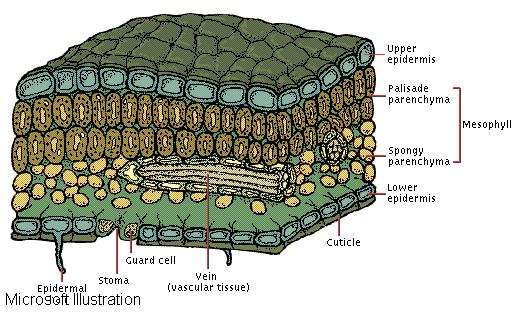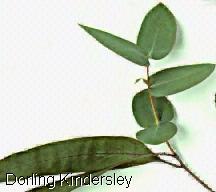

Coniferous trees constitute a large majority of the forestlands in Canada. Coniferous trees maintain their leaves year-round, while deciduous trees turn color and lose their leaves annually. Both types of trees can inhabit the same regions and forest belts. In this park in Québec, the deciduous trees’ bright autumn hues contrast with the deep green of the conifers.

The photosynthetic tissue of leaves consists of two types of thin-walled, flexible cells: the long, columnar palisade parenchyma, where most of the chemical reactions take place, and the irregularly-shaped spongy parenchyma. Both types of cells contain chloroplasts, photosynthetic organs that adjust their position within the cytoplasm for maximum exposure to the sun. Veins carry water and nutrients to the parenchyma cells. These inner structures, the parenchyma and veins, collectively called mesophyll, are sealed between layers of epidermal cells. Openings called stomata allow the entrance and exit of gasses. A transparent, waxy cuticle forms the outermost layer of the leaf.

An examination of leaves, stems, and other types of plant tissue reveals the presence of tiny green, spherical structures called chloroplasts, visible here in the cells of an onion root. Chloroplasts are essential to the process of photosynthesis, in which captured sunlight is combined with water and carbon dioxide in the presence of the chlorophyll molecule to produce oxygen and sugars that can be used by animals. Without the process of photosynthesis, the atmosphere would not contain enough oxygen to support animal life.

The green color in a normal holly leaf results from the uniform distribution of the green pigment chlorophyll. In a variegated leaf this important photosynthesizing pigment is reduced or lacking altogether in certain parts of the leaf, as indicated by the yellow color. Though the holly plant mounts a spiny defense against leaf-eating animals, its variegated leaves generally will not survive in nature due to this pigment deficiency.

In contrast to the rows of leaflets found on trees such as the walnut, a single, or simple, leaf arises from the buds of oak and maple trees. The netlike pattern of veins visible here is characteristic of dicotyledonous plants.

The arolla pine has needles that grow in bundles of five. Pine needles are actually highly modified leaves that are not shed annually but rather remain on the tree for long periods. Each needle has a tough outer layer called the cuticle, which in turn has a waxy coating that helps prevent water loss.

The eucalyptus tree has two totally different shapes of leaves on the same stem. The young leaves are small, circular, and completely encircle the branch, while older leaves are long, blade-like, and borne at the ends of short stalks.

The thick flesh of leaf succulent plants, native to marshes and semidesert conditions, swells in damp conditions to store as much fresh water as possible. Adaptations such as the white coloration and waxy, water-sealing coating of some leaves reduce evaporation. The leaves wrinkle as water is used.

The rhododendron is classed as an evergreen, that is, it does not replace its leaves each year. In order to survive the effects of wind, rain, sun, and insect predation, the leaves of the rhododendron have a tough, waxy upper surface. They also sometimes have a felt-like lower surface to help retain water and repel insects.

Compound leaves, although they appear to be a collection of many leaves, arise from a single bud. The leaflets fall as
a group in the autumn. The leaf pictured here is from a Hercules’-club. It is pinnately compound (with paired,
equally-sized leaflets arising from a central blade), and doubly so, with leaflets attached to matching side stalks. The
leaflets of palmate compound leaves, such as those of the horse chestnut family, radiate from a single point.
Leaves of monocotyledonous plants, such as the palm pictured here, usually have parallel leaf veins. Dicots show
netlike venation. Palm leaves, native to windy environments with little rainfall, have tough leaves that resist drying out.
The brilliant autumn colors characteristic of the leaves of many plants is due to the presence of accessory leaf
pigments that normally assist the plant in photosynthesis by capturing specific wavelengths of sunlight. These
pigments, called carotenoids, become visible when the leaf dies in the fall.
Dorling Kindersley
Compound Leaf," Microsoft® Encarta®.
Copyright © 1993-2002 Microsoft Corporation

Monocot Leaf
Dorling Kindersley
Monocot Leaf," Microsoft® Encarta®.
Copyright © 1993-2002 Microsoft Corporation

Colors of Autumn Leaves
Dorling Kindersley
Colors of Autumn Leaves," Microsoft® Encarta®.
Copyright © 1993-2002 Microsoft Corporation
Back to Plant Index
Design by:
